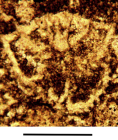Foraminifera taxon details
Zagrosaria Consorti & Rashidi, 2020 †
1453967 (urn:lsid:marinespecies.org:taxname:1453967)
accepted
Genus
Zagrosaria pinnata Consorti & Rashidi, 2020 † (type by original designation)
marine, brackish, fresh, terrestrial
fossil only
feminine
Consorti, L.; Rashidi, K. (2020). An enigmatic Maastrichtian small benthic Foraminifera of the Tarbur Formation (Iran, Zagros zone). <em>Cretaceous Research.</em> 115: 104557., available online at https://doi.org/10.1016/j.cretres.2020.104557 [details] Available for editors  [request]
[request]
Diagnosis Small-sized trochospiral shell. The dorsal side is evolute, flat to slightly convex and keeled. The ventral side is...
Diagnosis Small-sized trochospiral shell. The dorsal side is evolute, flat to slightly convex and keeled. The ventral side is strongly convex, involute, bulged and ornamented by feathered sutures. The first ontogenetic stage comprises roughly two whorls where the ventral side gets occupied by a central umbilical pile, producing a plug surrounded by vertical funnels. Chambers are prismatic to trapezoidal. They are roughly triangular in ventral view, wider than higher with a keeled acute periphery in the first ontogenetic step, then higher and inflated at the end of ontogenesis. The umbilical plate occurs in the early whorls. Ventral sutures are radial and feathered, especially towards the umbilical termination. Aperture composed by an interiomarginal row of pores in the early ontogenetic stage. The main apertural face consists of a finely-perforated plate that bears a wide central and double-bifid elongated slot. The slot is produced by a sort of hooked terminations of the ultimate chambers, possibly related to an umbilical flap. The canal system is composed of intraseptal interlocular spaces throughout, and funnels, placed between the pile and the umbilical plate, which extend along to the pile height. Sutural canals connecting with the intraseptal interlocular spaces are present. Dimorphism has not been observed. [details]
Hayward, B.W.; Le Coze, F.; Vachard, D.; Gross, O. (2025). World Foraminifera Database. Zagrosaria Consorti & Rashidi, 2020 †. Accessed at: https://marinespecies.org/foraminifera/aphia.php?p=taxdetails&id=1453967 on 2025-09-12
Date
action
by
original description
Consorti, L.; Rashidi, K. (2020). An enigmatic Maastrichtian small benthic Foraminifera of the Tarbur Formation (Iran, Zagros zone). <em>Cretaceous Research.</em> 115: 104557., available online at https://doi.org/10.1016/j.cretres.2020.104557 [details] Available for editors  [request]
[request]
From editor or global species database
Diagnosis Small-sized trochospiral shell. The dorsal side is evolute, flat to slightly convex and keeled. The ventral side is strongly convex, involute, bulged and ornamented by feathered sutures. The first ontogenetic stage comprises roughly two whorls where the ventral side gets occupied by a central umbilical pile, producing a plug surrounded by vertical funnels. Chambers are prismatic to trapezoidal. They are roughly triangular in ventral view, wider than higher with a keeled acute periphery in the first ontogenetic step, then higher and inflated at the end of ontogenesis. The umbilical plate occurs in the early whorls. Ventral sutures are radial and feathered, especially towards the umbilical termination. Aperture composed by an interiomarginal row of pores in the early ontogenetic stage. The main apertural face consists of a finely-perforated plate that bears a wide central and double-bifid elongated slot. The slot is produced by a sort of hooked terminations of the ultimate chambers, possibly related to an umbilical flap. The canal system is composed of intraseptal interlocular spaces throughout, and funnels, placed between the pile and the umbilical plate, which extend along to the pile height. Sutural canals connecting with the intraseptal interlocular spaces are present. Dimorphism has not been observed. [details]
